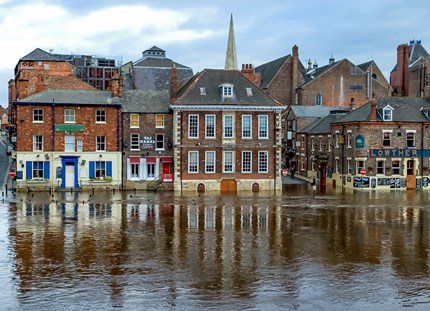Climate change is going to change the world – and financial services are going to smooth the way.
 Firms across the globe were already responding to changing risk, changing regulation, and changing demand - but when Covid became the main event of 2020 climate risk had to take a bit of a back seat. As everything begins to settle into a new normal, though, it is firmly back on track - and insurance companies are beginning to limber up, and even pick up speed.
Firms across the globe were already responding to changing risk, changing regulation, and changing demand - but when Covid became the main event of 2020 climate risk had to take a bit of a back seat. As everything begins to settle into a new normal, though, it is firmly back on track - and insurance companies are beginning to limber up, and even pick up speed.
The General Insurance sector has, in general, been lagging behind other services like banking, investments, bonds and pensions. Not in the habit of long-term future-gazing, climate change has been just another risk on a very long list, and getting Board and business attention on something with a 25+year risk horizon has often been hard. While it may have moved gradually from underwriters’ collective ‘emerging risk’ pile to the ‘developing risk’ pile - it has not necessarily been a strategic imperative.
We are really seeing a change in momentum now. Most insurance companies have set their plans for the year and have started to probe the uncertainties of physical climate change and some of the transitional impacts of the path to carbon reduction - both in the risks they manage and the capital they invest.
Getting off the starting blocks isn’t easy, so how are insurance companies focussing these conversations and building capacity? In our work with clients across the sector we’ve observed some key actions and behaviours that could help firms get climate-risk fighting fit, and even give them the edge over other competitors.
Understanding the race
We’ve found that the companies getting traction on climate change are the ones that are getting the Board on board - early. They need to understand the race, and the implications of a slow start.
Setting the right level of attention for the business really is crucial, because although the risk horizon may be past their tenure, the actions and decisions the Board make now will impact the firms’ financial stability far into the future. Collecting the knowledge, practice and skills to turn the ship AFTER climate change risks start to manifest will just be too late. The understanding, feedback loops and processes needed to monitor and respond may take years and iterations to develop and embed. In short, you’ll always be trying to catch up.
Once everyone’s committed and in the same race, the Board must help define the right changes to governance and development of appropriate scenario analysis. Climate change risk disclosure needs to become part of reporting cycles, but this is the end game; keeping that in mind will help clarify what is expected of firms and what information the audience requires. Leadership needs to be involved also to ensure plans remain on schedule, pragmatic and aligned to material financial risks. The responsible person and climate risk teams should also be staying abreast of the work being done by industry working groups, regulators and competitors. There is a great deal of discourse happening at the moment and being involved will help clarify and define the work now and keep teams informed of best practice as the market creates this.
 Those firms putting in the groundwork and investing time in this preparation stage are already seeing benefits.
Those firms putting in the groundwork and investing time in this preparation stage are already seeing benefits.
Having a strategy
It’s not just about running the race, all great athletes have a STRATEGY that overarches and underpins every step they take.
Insurers are, by definition, pretty good at weighing up risks – but it’s not always done at a strategic cross-cutting level. Too often we see risk plans developed in isolation, without considering interlocking interdependencies. Climate risk management needs to be part of a wider strategic risk management framework, not bolted on to the back as an afterthought. It will impact risks and strategic goals that already exist across the business, from cyber to operations, pricing to culture, wider sustainability impact to underwriting - and beyond.
For many organisations that’s meant making fundamental changes in processes, operations, and leadership - pulling down existing business silos and rebuilding with appropriate collaboration and sharing of expert knowledge.
Getting in the right mindset
In order to win on climate change risk, everyone’s head has got to be in the game.
Corporate culture might not seem like an obvious pillar of climate risk management, but the long horizon and level of change to business skills and structures needs support from better business culture to maintain momentum.
Driving change and staying on course to continuously tighten and learn from past iterations requires an adaptive and honest approach to what’s working and what’s not, collaboration across departments, teams and business areas, and transparent communication between the business, leadership, expert knowledge and Board.
The leadership and Board can set the right culture to steer appetite and keep the right focus, driving consistent messaging and action, and encouraging and empowering colleagues to be curious, client focussed, and forward-gazing. The more eyes on the horizon, the more innovation, opportunity and authority are able to flourish.
Running the scenarios
There’s lots of things that can happen in any race, and the firms who will do well understand that these things can be planned for. Scenario analysis is an important part of mapping out climate change risk.
Though modelling and stress testing are BAU for insurers, the methods and data required for the sort of long term, intangible and ever-changing climate risk scenarios are very new. Firms need to allow teams creating and testing these scenarios to experiment and iterate. Not getting it right the first time is certainly part of the learning process. Teams need to be given appropriate time and space to do this and build learning. Bringing in new people - as part of the team or as external ‘coaches’ - may be necessary in order to upskill and add weight of experience.
It’s also key to allow teams time to collaborate with industry groups and regulators to share and gain knowledge.
Keeping your eyes on the prize
This race is a marathon, not a sprint. We always encourage clients to look up, and not get bogged down in the weeds. Don’t look at the minutiae of a risk until you understand the broad picture and general level of impact. Don’t look at data in-depth while collection is in its infancy, or it’ll skew your view.
Build learning and set annual goals to keep it fresh. It is also important to keep perspective by reviewing progress and plans each year. Keeping your eye on the finish line and keeping the right momentum over the course of years is a key part of the experience.
That focus and clarity will resonate with everyone you want supporting you from the sidelines - regulators, investors, employees and customers.
